By Jeffrey A. Rendall, Photos By Jeffrey A. Rendall
|
|
LANAI, HAWAII � One common misconception about the Hawaiian Islands is that they�re entirely tropical. Seeing the advertisements, you really can�t blame people for believing the entire state looks like the Amazon jungle with lush foliage and palm trees, sparkling waterfalls and all the coconuts and pineapple you can eat.
But what the ads won�t tell you is there�re usually rainy and dry sides to each island, with some other sub-climates in between. Within the span of a few miles, you might be in one of the wettest or driest spots on earth � it happens that quickly.
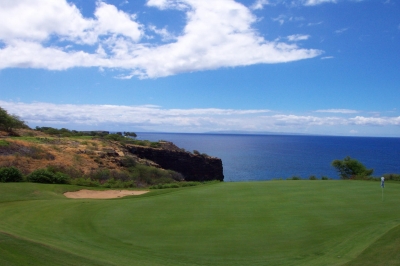 |
| Here's the view from in back of the 12th green. Deep blue sea, and a little golf to enhance the landscape. |
The golf courses on the Island of Lanai are good examples of this wet/dry phenomenon, with the mountaintop �Experience at Koele� representing the lush and green, and the seaside �Challenge at Manele� appearing on behalf of the drier microclimates.
We looked at the Greg Norman/Ted Robinson designed �Experience� in a separate review � here, we�ll examine the story behind the Jack Nicklaus inspired �Challenge� course.
Their respective settings aren�t the only differences, as Director of Golf Doug Stephenson describes: �Whereas the Experience is kind of a mountain-style course carved out from the forest, the Challenge is pretty much a similar design variety to what you�d see in a desert environment, more target-style to fill in the golf course. You�ll be shooting shot to shot around the natural topography, and you play over a lot of natural areas on the straight grade.�
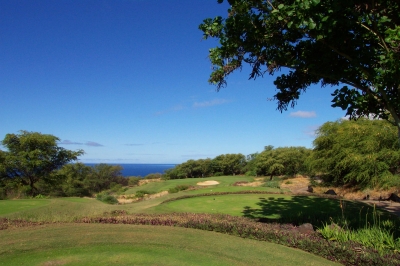 |
| From the tee of the par three 3rd hole. That big bunker actually juts into the green, and if you're on the wrong side, you're looking at three putts minimum. |
Stephenson continues, �The interesting thing about the Challenge � you have an ocean view from every hole, because the golf course runs from the water up the mountain on the side of the hill there, and usually faces down. The whole design concept here is to really take advantage of the topography, and Nicklaus did an outstanding job of doing just that.�
Most reviewers have agreed with the assessment, as The Challenge is rated highly in publications from sea to shining sea. One member of our party pronounced The Challenge as his favorite Hawaiian course � and when you consider some of the others we saw, that�s pretty high praise.
Dave Heatwole, Nicklaus�s Project Manager at Manele, echoes Stephenson�s comments: �The terrain was interesting because basically the entire site pitched toward the ocean, which makes for outstanding ocean views from just about wherever you are on the golf course. At the same time, the nature of the land required many of the golf holes to be carved into the existing slopes, which also meant that most of the holes had to run parallel to the ocean.�
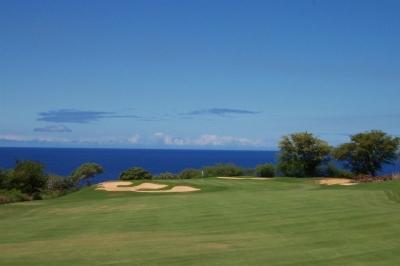 |
| You can't see the landing area off the tee of the par four 10th hole, but you'll definitely be able to see what you have to do on the approach. |
�The existing ravines that cut through the property had a big influence on the routing of the golf course as many of the tee shots and a few second shots require a carry over these natural features,� Heatwole added.
For that reason, the course appears to play more difficult than it actually does. Stephenson pointed out that the Challenge is wider than its mountaintop sibling, though if you�re off the grass at the lower course, you�re reaching for another ball. Nicklaus is known for creating demanding tee shots, yet always provides a plethora of room for the average resort player as well. The Challenge certainly fulfills this mission.
Though every hole features those ocean views, a few actually play right on the water � or, should I say, on the high cliffs overlooking the deep blue. Wow, that�s as blue as blue gets.
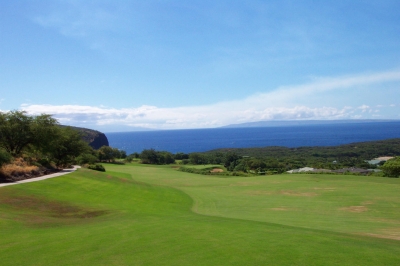 |
| The par five 6th hole is a good example of how The Challenge at Manele fits the land. The hole moves towards the ocean, with views to match its creative layout. |
But Heatwole says the proximity to the water also brought some construction challenges. �The State of Hawaii required a 50-foot setback from the edge of the cliffs along the ocean for environmental reasons. Many of the existing cliffs actually overhang a bit, so the 50-foot setback is also a safety measure. During construction of the golf course, a lot of the heavy equipment operators were reluctant to venture too close to the setback because of the overhanging nature of the cliffs.�
Who can blame them? After finishing up on the signature par three 12th hole, we journeyed a few yards off the green towards the ocean, and you won�t have to go very far to get yourself in a tight situation. Driving a big piece of machinery in that setting had to be quite a �challenge� in itself.
Just getting the machinery to Lanai to build the course was a chore as well. Heatwole said the island�s relative isolation created some unusual logistical difficulties � getting materials and equipment for construction, but the Nicklaus team worked closely with the contractors to overcome them.
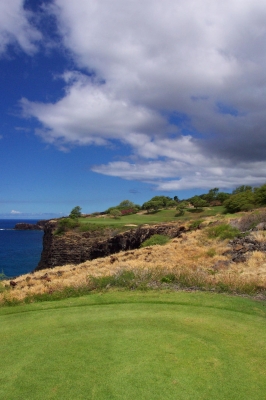 |
| On the par three 12th hole, you're shooting from one cliff to another... and it's a long way down if you don't fly it over. |
Despite the problems, the course was completed in a little under nine months, and opened less than a year from its groundbreaking (in late 1993). �The nature of the site, which was all lava rock, required a lot of blasting along with using some of the largest pieces of heavy construction equipment that I had ever worked with on a golf course construction project,� Heatwole observed. �And during the design and construction, we had to be more aware of the impact of the winds than we might experience on most golf courses.�
We played in the morning with relatively light winds, and the temperatures were in the low 80�s � clear and Hawaiian sunny. Looking at the ocean, it�s hard to imagine a better setting for golf.
The Challenge won�t punish you while you�re seeing the sea, either. Again, Heatwole expounds, �The primary goal of the project was to create a fun, fair and memorable golf experience, yet also provide a challenging experience for the resort guest or any player.�
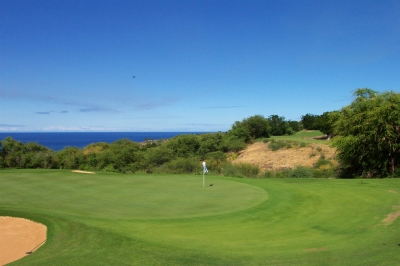 |
| From behind the green on the short par three 7th hole. Clubbing from the tee will certainly depend on the pin location. A benign looking hole that can really bite you. |
Nicklaus clearly didn�t venture across the sea to build a golf layout that only he could play and enjoy. But he also didn�t want to create something that you�d recognize as one of his projects. �Jack doesn�t like a golfer to be able to walk to the first tee, stand there looking down the fairway and say, �this is a Nicklaus golf course,�� Heatwole explained. �He would hope that his trademark is that there are no trademarks. Jack�s main goal in designing the course was to work as closely as possible with the unique existing natural features of the site, while also fitting the golf course into the master-planned future development of the property.�
Sure enough, some of that future is happening now. There�s a fair amount of construction going on around the front nine, as there�re some lucky future residents who will be calling Lanai home very soon. Now that�s a view from the back deck.
But even here, Nicklaus had some influence. �During the early stages of the design process, Jack convinced the client and the land-planners that the value of the real estate and the quality of the golf experience would be greatly enhanced by having the golf holes directly on the ocean with the real estate overlooking golf and water, as opposed to some of the original concepts, which had development along the water,� Heatwole said.
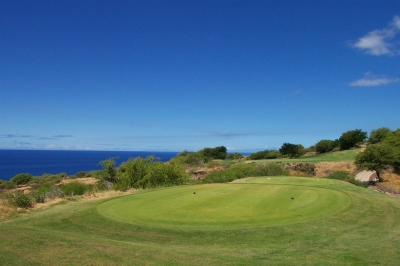 |
| From the tee of the par five 11th hole -- you'll grasp the target nature of the golf course. |
Stephenson said he enjoyed getting to tour the layout with Nicklaus when it was under construction � and it was quite a learning experience to see the world�s greatest player at work in his design element. �He made a few adjustments when I was out there with him, and it�s helped me understand the course the way it is today.�
One of the ways it is today features the use of a �cutting edge� saltwater tolerant grass, called Paspalum. Since the Challenge is on the �dry� side of the island, water is constantly an issue. For that reason, the Challenge�s management began experimenting with different types of grasses, including Paspalum. It�s taken so well that Stephenson said eventually all the greens will be resurfaced with it.
You can even water it with seawater. Talk about the wave of the future.
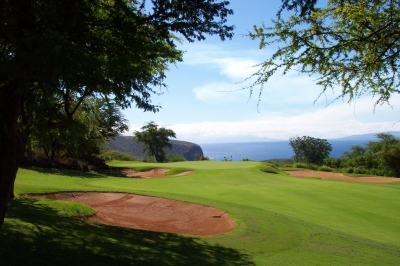 |
| The par five 4th hole's green slopes severely on all sides. At 506 yards (and the second shot's downhill), it's definitely reachable for long hitters -- but if you miss slightly on the approach, it'll be a tough up and down for a birdie. |
One final unique feature of the Challenge is its holes makeup. Stephenson says that both resort and better players really like the fact there are five par threes and five par fives (three of each on the front nine, including back-to-back par threes). There�s a tremendous amount of hole variety, which yet again proves the Nicklaus group did their job. This isn�t just a golf course by the ocean � it�d be a nice layout anywhere.
Hole highlights include the fifth hole, the course�s #1 handicap hole (par four). The tee shot�s semi-blind, as you can�t see the entire shape of the hole, but the fairway strongly suggests a draw. It�s the highest point on the golf course, furnishing an incredible panorama of ocean and beach. The second shot drops sharply, making the hole play much shorter than its 462-yards.
The sixth hole continues your journey down the mountainside. At 544 yards (par five), it�s possibly reachable in two, but the green�s well bunkered should you decide to give it a shot. One of the better birdie opportunities on the course, certainly one you�ll remember.
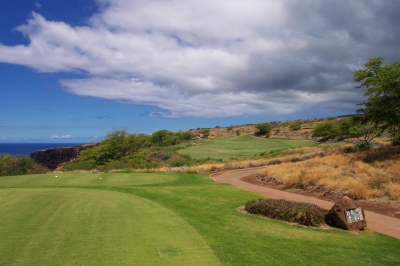 |
| The short par four 13th hole is driveable for some -- but the green isn't very wide. The safe play is to lay-up with an iron. |
On the back, the closing stretch is probably the best sequence of par fours on the course, beginning with the 16th hole. There�s a bunker that splits the tee shot landing area, providing the option of going to either side, which will shorten or lengthen your approach shot accordingly to this dogleg left, 458-yard hole. The green is kidney shaped and elevated, which will certainly test your ability to control the distance on your irons as well.
The seventeenth hole tees off over a cavernous ravine, with the ocean deep below. From the back tees it�s 220 yards of carry to reach the other side, so better hope for a favorable wind. The second shot again plays downhill. Stephenson says, �on the holes right there close to the water, you get a lot of variable winds � off-shore winds and trade winds, so it makes the holes play different every time.�
For those fortunate enough to play the Challenge at Manele enough to know, it must be a continually enjoyable experience. But for the resort players who only get once around, you�ll definitely remember the views. Just what Hawaiian golf was meant to be.
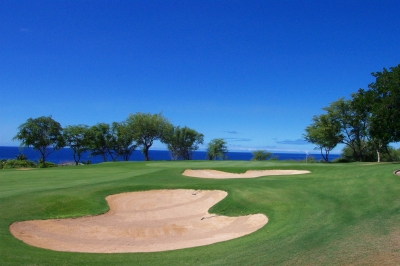 |
| At 556 yards, the par five 9th hole is a three-shotter for nearly everyone -- and there's more than adequate protection against people trying to cut off too much from the 3rd shot. |
If You�re Staying On Lanai
We didn�t get a chance to go there, but a fun-sounding afternoon excursion would be to go to Shipwreck Beach (on the north side of the island), which earned its name because of powerful offshore currents that have led many seafaring ships to meet their watery demise within sight of the beach. The first documented wreck was the British ship �Alderman Wood,� which sank in 1824.
Not for swimming, we�re told, but you�ll be able to see the �remains� of a World War II Liberty Ship clinging to a reef near the shore. Though this particular ship didn�t end up here because of an accident, you�ll still get the idea � and harken back to the sunken ships that arrived there through more �natural� and tragic means.
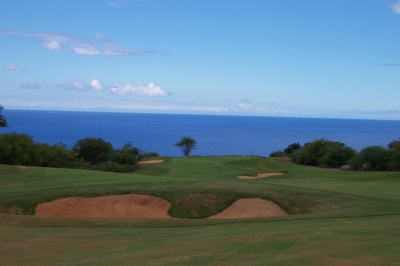 |
| Standing near the big bunker in the middle of the 16th fairway. A cloud blocks the sun, but it hardly spoils the view. |
Not to mention the views of Lanai�s neighboring islands, Maui and Molokai. Rental vehicles are available at both resorts.
Details:
The Challenge at Manele (Four Seasons Lanai Hotel)
Lana�i
Phone: (808) 565-2222
Website: www.fourseasons.com/manelebay/
Nicklaus�s Project Manager at Manele: Dave Heatwole
Director of Golf: Doug Stephenson
Tees/Yardage/Slope/Rating
Nicklaus 7039 135/73.7
Gold 6684 130/72.1
Blue 6310 126/70.4
White 5847 123/68.3 129/73.2 (L)
Red 5024 115/64.6 119/68.8 (L)
Rates:
$185 for a guest of the hotel, $225 for a day visitor. Fee includes cart and range balls, and is an all day fee. If you�d like to play the Experience at Koele on the same day, there�s an additional $70 fee.
Note: At press time (10/2005), both the Experience at Koele and the Challenge at
| Related Links | Comments on this article? | |
|
Maryland National Golf Club Hollow Creek Golf Club Rocky Gap Resort PB Dye Golf Club in Ijamsville Whiskey Creek Golf Club |
E-mail Jeff Rendall, Editor: jrendall@golftheunitedstates.com |













